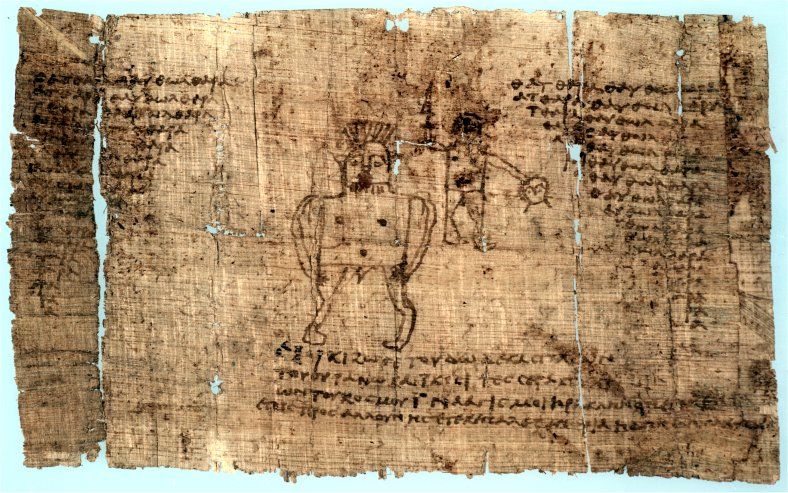Working The Headless Rite from the PGM in a time of grief.

The Headless Rite, also known as The Bornless Ritual, or The Stele of Jeu, a rite from the Greek Magical Papyri (someone else will likely do better at telling you what the PGM is) is touted by many as a particularly powerful rite and many exthol its virtues, claiming that its performance will reap many benefits. I'm not going to argue with anyone else's claims, that's not my position here. I simply wish to relate my experience with it.
I first became familiar with this particular rite as The Bornless Ritual as published in Liber Samekh by Aliester Crowley. I studied some Crowley, off and on, for years; but his presentation never really reached me. I'm quite sure my methodology of magic as performance owes something to my early exposure to Crowley, but I can not attribute all of it. I never performed any of his rituals. I didn't understand what the text was when I came across it. Personally, I think even less of it now than I did then... but that's a personal thing. Don't take offense if you happen to eat, breathe and sleep Crowley. More power to you, if he's your thing.
In whose lap did you lay your head when last your heart was broken
I'm sure I came across the rite in other forms over the years, having exposed myself to the writings of magical author's of many different stripes. But again, I never investigated it further or performed it. Of late, I have taken my magical practice to heart and taken the practice of magic as performance head on. This is due, in no small part, to the influence of Mr Gordon White who seems a kindred spirit in many ways (I don't agree with everything he says... hell, I don't understand everything he says). I came across The Headless Rite, again, in his book The Chaos Protocols. I determined, at that point, that I would perform the rite.
It took me quite some time to get around to actually doing it. Not because I'd returned to my arm-chair occultist ways, but indeed because I was off doing and exploring so many other things (not the least of which would be Mr Tommie Kelly's Forty Servants). I had wanted to get my own copy of Betz's Greek Magical Papyri in Translation before attempting it, for flavor and for grounding (but I'd already been exploring elements of the PGM through the writings of Kadmus and Leonardo and brushes with Kemetic Reconstruction).
Due to the ritual's solar character, I planned to start my performance of it on the Summer Solstice, 2017. Due to personal restrictions, I set myself to five performances in total. What I had not planned on was the upheval in my personal life that occurred just before my performance was scheduled. I'm not going to delve into much personal detail, but it is appropriate to say that I was dealing with grief. A relationship that holds significant value for me came to an abrupt and untimely end. I was heartbroken.
The ritual, like many contained in the PGM, has no explanatory notes or context. We must make of it what we will. I am in agreement with those who have called it a rite of exorcism (or protection). But the bulk of the ritual is preparing the magician to assume the authority to perform said exorcism. There are exemplary examinations of the text available, and it is not my intent to rehash them; you are free to seek them out if you wish.
Grief is like possession. Any intense emotional state is like possession. You've heard the same claim before: "love is like insansity". Don't get me wrong here. I'm not saying or even suggesting that one should exorcise their grief without processing. Nor am I suggesting that any of these boil down to psychological conditions. I am not of the "everything is mind" camp. I'm a poet, employing a similie. Or a magician communicating the way a magician ought: symbolically. "LIKE" is the operative word here.
That being said, I believe the timing of my performance was a great aid in processing my grief (I'm not done yet). It wasn't so much the exorcism part of the ritual, I don't think, but the evocatory and invocatory parts that were the most powerful. The exorcism is in there, and I think it matters. But its the rest of it, the claiming of authority and the evocation leading to invocation (we all know the difference, right? I've been guilty of using one when I meant the other because of common usage and not using them as terms of art) that is the true strength of the ritual and why I think it has had its several revivals and claims for miraculous affinity.
In the end, I think its more than an exorcism or rite or protection, though it functions as one and the key is in its structure. The Headless Rite is a progression and I believe its repeated application under a variety of circumstances and for a variety of reasons can only prove beneficial. One might also look to it for clues in creating their own ritual, but I think that Bes is on a mission right now and I'll support the dancing dwarf by recommending this here.
Inimicus Dei Constituitur
